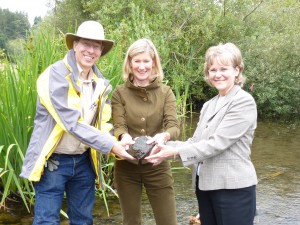Weir getting closer . . .
Posted By Dwight on September 11, 2010
] Jane Hague & Kathy Lambert with Dwight at the weir; this stone “rip rap” is still visible in the mid channel but is under up to a foot of accumulated growth and silt in the high flow channels which drain the lake in the winter months.
Jane Hague & Kathy Lambert with Dwight at the weir; this stone “rip rap” is still visible in the mid channel but is under up to a foot of accumulated growth and silt in the high flow channels which drain the lake in the winter months.
On Thursday, September 9 King County Council-members Kathy Lambert and Jane Hague and county hydrologists and engineers joined representatives from Dave Reichert’s office and the City of Redmond–as well as a number of concerned Lake Sammamish residents–to take a closer look at the weir and the area that was recently mowed. This meeting was a result of an earlier King County Flood Control meeting, and was scheduled by Council-member Lambert’s office.
Before the meeting I went out to the weir to set up a few visual aids. I set my laser level–which rotates a full 360 degrees–on top of the weir at a height of three feet. Then I followed the laser beam and tied flags at that height on the vegetation surrounding the weir. This illustrated how high the water gets at Elevation 29: a significant flood stage design level. It also demonstrated how much of this area is filled by the “wall of willows”, logs, root balls, tall grass, accumulated silts, and other debris.
My earlier posts discussed the record high water levels we had this spring. This meeting was a great opportunity to show the County areas where flows are running into accumulations of debris which are blocking flow and were never intended in the original design. I recently noticed what appears to be up to a foot of accumulated silts and turf like growth in the high flow channel. Perhaps years of accumulated materials has raised the channel, which has a direct affect on lake levels. One observation is that the left channel is about one foot higher than the right. They should be the same.
We discussed next steps, I suggested removing the obstructions in the high-flow channel, logs and debris at this critical location are inappropriate. If willows must by maintained just below the weir, then limbing the tangle of low branches so that water can flow more freely would be a step in the right direction. A fish biologist was also present, he pointed out that this kind of habitat promotes bass who devour salmon as they migrate out to sea.
County hydrologists are studying the situation and want to be sure they fully understand it before they recommend a course of action. I am concerned that we are about out of time, fall is in the air and forecasters predict a wet and cold winter. I am glad that the County staff are taking this seriously, and want to thank Council members Hague and Lambert for coming out and marching through brush, water, and mud to see it for themselves!

Comments